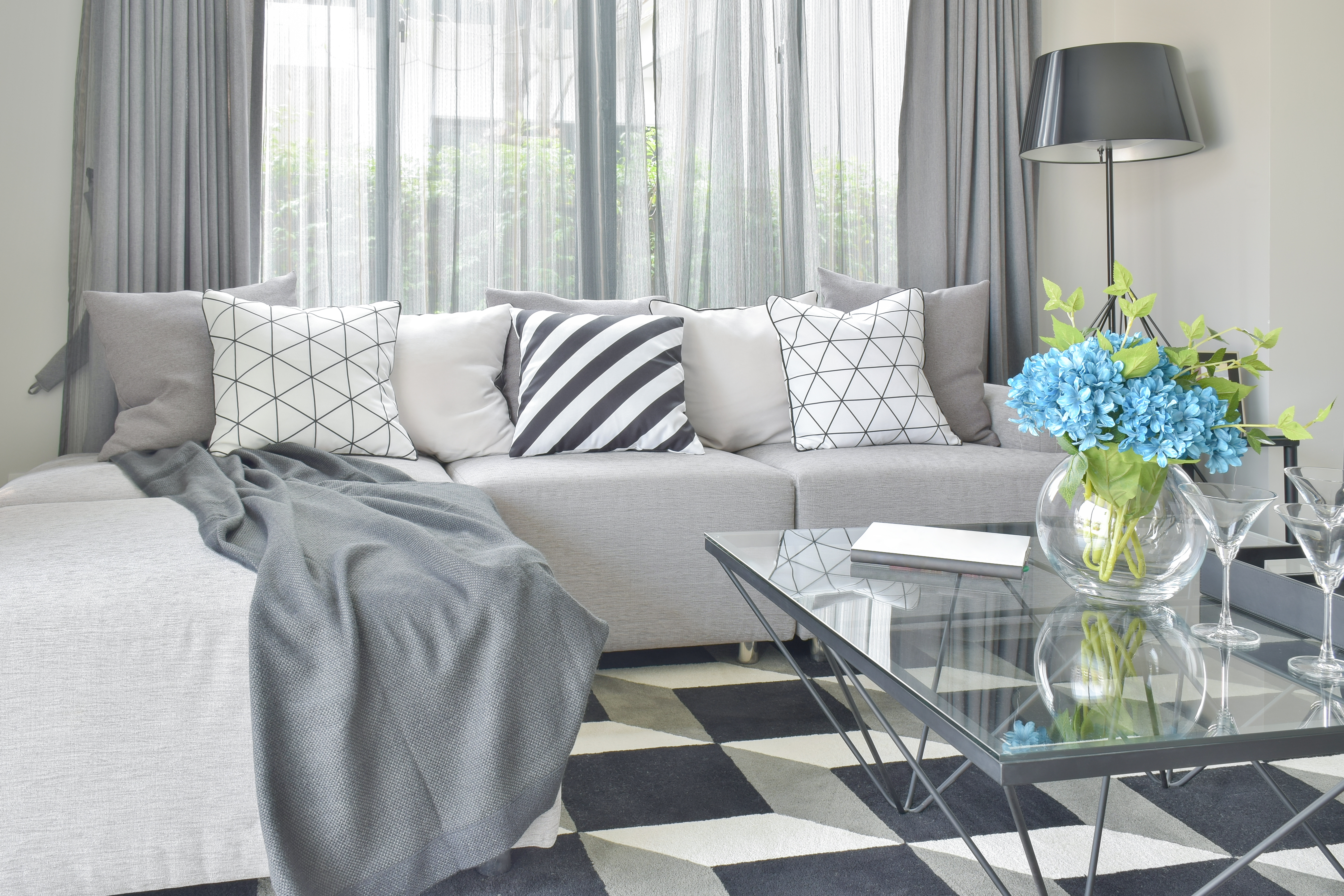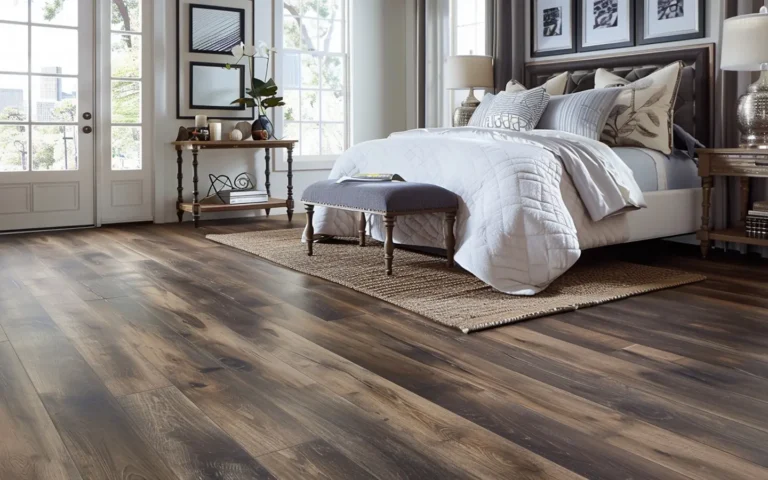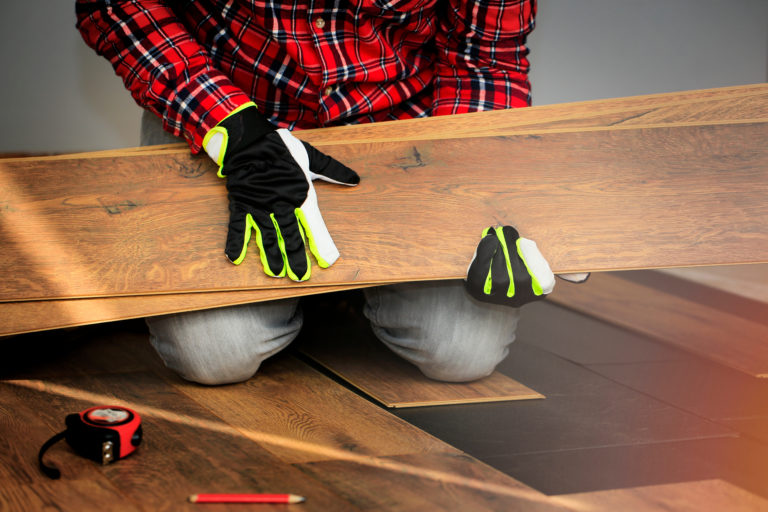This post may contain references or links to products from one or more partners of our parent company and/or subsidiaries of our parent company. For more information, visit this page.
Updated May 9, 2022
Wondering how to install carpet tiles? We don’t blame you. Of all the wonderful types of flooring out there, carpet tile is a bit of an unsung hero. Why? Because peel-and-stick carpet tiles—aka modular carpet—offer all the best qualities of carpet along with exceptional versatility and ease of installation.
Look, everyone knows that the carpet vs. hardwood debate—and even the carpet vs. laminate debate for that matter—usually comes down to the massive differences in installation. Because learning how to install hardwood floors is a hassle. But learning how to properly lay, seam, and staple wall-to-wall carpet… that’s an absolute nightmare. Basically, carpet tiles have completely redefined the way people can install fuzzy floors.
But we know: you’re already searching for “how to install carpet tiles”, so you probably know all the pros and cons of carpet tiles already. That’s why below, we’re going to show you how to install carpet tiles to perfection in just 7 easy steps. And when we say “easy”, we mean it. Let’s get started.
But before we talk about how to install carpet tiles…
Let’s talk about choosing the right product for you. After all, the success of your installation is going to depend on the actual carpet tiles you buy in the first place!
So first things first: forget the modular carpet tiles you used to sit on for preschool story hour. Those rough, uncomfortable carpet squares are a thing of the past. Today, carpet tiles today come in so many colors and patterns, you can mix and match to your heart’s content.
Let’s talk about the different types of carpet tiles available
These days, many of the best carpet brands also make carpet tiles. Most of these are for commercial carpet, and install in the classic “peel and stick” format.
Others, like the machine-washable carpet tiles from Proximity Mills, are made from the same super-comfortable materials that you’d find in any other top stain-resistant carpet—and they install using friXion pads rather than adhesive. You have options!
Just make sure you know what you’re buying
However, this variety means you need to be clear on what you want before you begin. Want a black and white checkerboard pattern? Solids and florals? Berber? Cut pile? Loop pile? Whatever types of carpet you choose, make sure you have a vision in mind before you start. This is one of the most common mistakes people make when installing carpet tiles—pulling them up and redoing them again and again.
And while peel-and-stick carpet tiles do give you the opportunity to re-lay your floors multiple times (one of the reasons they’re such a great do-it-yourself flooring project), you will degrade your glue layer with repeated lays.
Once again: the exception here is Proximity Mills, whose carpet tiles can actually be taken up and put back down indefinitely thanks to their non-adhesive installation style.
Best Brands of 2024
The main event: how to install carpet tiles in 7 easy steps
Of all types of flooring, carpet tiles might be the easiest to install. No special tools or skills needed. Just a bit of time, patience, and imagination.
Step #1: Evaluate your tools and determine what you’ll need to buy
No need to run out and buy expensive power tools you’ll only use once—here are the only tools you’ll need to install carpet tiles.
- Measuring tape: Make sure you have a measuring tape at least long enough to get from one end of the room to the other.
- Chalk line: A chalk line is a spool of string that lays down a chalk line when you snap it down. If you don’t have one already, you can pick up one for less than $10. The cool thing about chalk lines is that once you have one, you’ll think of a million other uses for it. Trust us on that.
- Scraper: You’ll need a sturdy metal scraper to help with removing any imperfections or adhesive from your subfloor. What is subflooring? It’s the raw material that serves as the base for your floors. Carpet tiles can be laid over existing surfaces as well, but these will need to be prepped just the same.
- Pencil: Have a pencil on hand to take down all your measurements or scribble secret messages on your subfloor to be found by your great-grandkids.
- Square: It’s hip to be square. Or so Huey Lewis tells us. Cough. Seriously though, there’s nothing worse than having to pull up a half-laid floor because you didn’t make sure your lines were square. Make sure to buy a t-square or framing square in advance (you can also use it to measure lines for your tile cuts).
- Double-sided carpet tape: Even if you’re using the peel-and-stick carpet tiles Home Depot and Amazon sell by the crate, make sure to get some double-sided carpet tape as well. You can use it to fix any problem areas or to reinforce your corners.
- Utility knife: File this one under “awesome carpet tile benefits”. You can cut and trim carpet tiles with a utility knife. You don’t need anything fancy, but you know what? Get yourself a nice one. It’ll cost you less than $20 for a tool you’ll use again and again.
- Hammer: This one is optional. The truth is, you never know what your subfloor looks like until you remove the old flooring. It never hurts to have something around to smash things with.
Step #2: Prepare your surface
The ideal scenario for any flooring project is starting with a clean, flat, level surface. Pull up any old vinyl, carpet, or tile wherever you’re planning on installing your carpet squares. If you currently have click-together flooring installed, that should be easy—just disassemble the click-lock planks (disassembly is certainly not one of the disadvantages of floating floors).
If you’re working with some types of wood flooring, however—solid wood in particular—this might be more of an issue. Just remember: you can install most types of carpet tiles over existing flooring. And if you’re thinking about ripping up solid hardwood to put down carpet tiles… just don’t. After all, the cost to replace carpet with hardwood is much higher than the cost to replace hardwood with carpet.
Whatever surface you’re installing carpet tiles over, use your handy scraper to smooth out any imperfections. Remember that hammer? Fix any splinters, nails or screw heads that may be poking out.
Also, make sure that your subfloor is secure. This is a good time to address any weird squeaks caused by loose fasteners. If you’re looking for ideas on how to replace flooring like a pro, take it from us: a secure subfloor is the secret sauce.
Step #3: Begin from the center and work outward
Most people think that when laying carpet tile, you just start from a corner and go from there. Au contraire, mon frere. That’s a one-way ticket to janky floors.
Rather, you need to find the center of your room and work outward from there. By starting in the center, you ensure that you’ll get entire, unbroken carpet squares in the majority of the room with cut squares just on the edges and walls—rather than vice-versa, which (take it from us) looks terrible. And that goes for all types of tile, not just carpet tiles.
So whether you’re installing snap-together tile flooring in your bathroom or cork flooring tiles in your kitchen (lots of the best cork flooring comes in tile form), this is something you’re always going to want to keep in mind.
Our advice? Use your tape measure to locate the center of each wall. Stretch out your chalk line from the center of the first wall to the center of the opposite wall. Then, do the same with the other two walls, dividing the room into four quadrants with an X in the middle. That X marks the spot where you’ll begin. #Math.
Step #4: Line up, lay down, repeat (the “how to install carpet tiles” mantra)
Okay, so we’ve got our lines chalked and we’re ready to begin. Starting from one corner of the X, begin installing your carpet tiles one at a time. Remember, your carpet tiles may be directional, meaning you have to lay them down in a specific way.
If you’re not using peel-and-stick carpet tiles (just ordinary modular carpet squares), make sure to pay extra attention to the corners when you apply your adhesive. Make sure that all the corners are firmly glued down before moving on. And again: make sure you’ve started from the center of the room and measured outward. Regardless of what types of flooring you’re working with, this is a big ‘un.
Oh, and starting from the middle of your X has an extra benefit—you get to lay down a bunch of whole tiles before you have to start making cuts. But eventually, the honeymoon will end. Which means…
Step #5: Measure twice, cut once
This is sound advice no matter what you’re installing, from the best bamboo flooring to fake wood flooring and everything in between. Do not—and seriously, we can not stress this enough—do not cut before doing a double-measure. Just don’t do it. It’s really, really not worth losing material you paid for.
Look, one of the things we recommend in our guide to buying wood flooring is to add an extra 10% on to your material needs. And that’s because everyone measures and cuts incorrectly, and then needs more material. Don’t be one of those people. Whether you’re putting in some fancy wood floor designs or just patterned carpet tiles, make sure to measure properly. It’s what Ron Swanson would want.
Here’s what to do: take your measurements, check your measurements (yes, that’s the second time), and use your t-square to draw a line on the back of your tile. Your utility knife will slice through the carpet tile very easily, so again—make sure your measurements are correct.
Step #6: Roll it out and press it down
Once all of your carpet tiles are laid down, you need to make sure it’s fully “glued” and flat. This includes peel-and-stick carpet tiles as well. Pay particular attention to the seams between the tiles. Check each one to ensure that they are fully stuck to the floor, without any gaps or loose adhesive, the same way you’d check the best types of vinyl flooring (or just the vinyl roll laying around your parents’ garage).
You can rent a roller from a home improvement store or find something creative around your house to roll the floor down. Maybe you can finally find a use for those dumbbells collecting dust in your basement. No judgment.
Step #7: Get Instagram-ready
Hey, hey, that carpet is looking okay! Now it’s time to take a really close look at your work. Clean up any stray fibers and or weird edge cuts. Once you have it all cleaned up, you can install your trim. Run a vacuum over everything and get ready to take those Instagram pictures. Not even the best hardwood floors look better than a surface you laid yourself!
Now, pour yourself a drink. You’ve earned it.
How to Install Carpet Tiles: Conclusion
Now that you know how to install carpet tiles, it’s time to find some of your own. Remember: carpet tiles are some of the most durable, versatile, and customizable flooring options available today. But: like anything else, there are tons of things to consider when making a purchase.
Are Home Depot and Amazon carpet tiles worth it?
This is a question we hear all the time. And the answer is… it depends. If you’re looking for quick and easy, then yes—it’s hard to beat the carpet tiles Home Depot and Amazon sell by the crate. But: if you’re looking for the most long-lasting, beautiful, and comfortable carpet tiles around, you might want to do a little more research.
Our advice? Find a local flooring store in your area. Independent retailers usually carry the very best products and can help answer all of your questions. We’d also highly recommend the LCT (“luxury carpet tile”) products from Proximity Mills; they’re basically the only machine-washable carpet tiles around, and they’re miles above the competition when it comes to quality..
And for more info on all things floors, from deciding between tile vs. laminate to finding the best engineered wood flooring, read on! Here are some of our top blog posts:
- What is Laminate Flooring: Laminate 101
- The Pros and Cons of Cork Flooring
- Pergo Reviews 2020: What Buyers are Saying
- Laminate vs. Hardwood Floors: Which are Better?
- Engineered Bamboo Flooring: Pros and Cons
- Comparing Tile vs. Wood Floors for Your Home
- Wood Flooring Cost: Your Complete Guide
- Bamboo Flooring vs. Laminate: Which to Buy?
- The Most Durable Types of Wood Flooring
- 6 Cheap and Strong Hardwood Floor Alternatives
About The Author

Dr. Sara Austin
May 4, 2020
Best known for being “not that kind of doctor” and never knowing which fork to use, Sara is a learning designer and writer, former real estate agent, and builder with a penchant for home design and remodeling.






